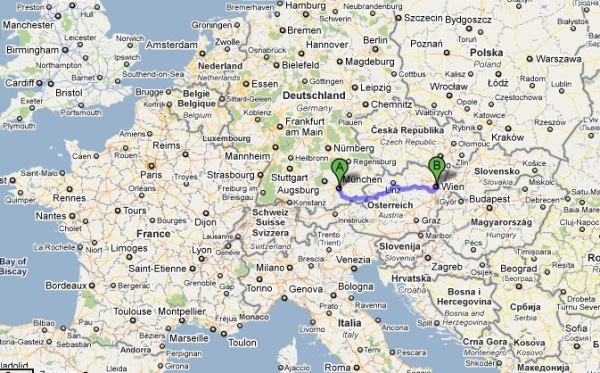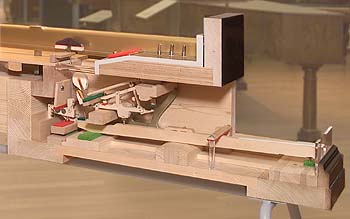Crazy Keys at the Technical Museum in Vienna
 Thursday, March 17, 2011 at 9:00
Thursday, March 17, 2011 at 9:00 On a recent weekend trip to Vienna, Frau A and I spent a morning at the Technical Museum of Vienna. The exhibit that I really wanted to see was on musical instruments. This collection alone was worth the trip east from Munich.

The items represent a great combination of music and technology. For example, the "piano maker's workshop" has instruments along the evolutionary tree of the modern piano including harpsichords, spinets, clavichords, a tangent piano, and finally the earliest forte pianos. Even better, they have working, "cutaway" examples of the key mechanisms for about 8 different instruments, so you can see into the guts of how the sounds are actualized -- here's one example of a modern piano:

Most interesting to me were the esoteric instruments that pushed the envelope (in their time) for the type of sounds created, the method of playing and level of musical control, or even automation of the instrument(s). I took photos of my favorites and will briefly describe them here.
Pictured below is the Janko keyboard. Theoretically, the Jankó keyboard had a number of advantages with regard to playing technique: the same finger set for all keys, a natural hand position (the thumb always lies lower than the rest of the fingers), a broader range than a normal keyboard, as well as Glissando possibilities in all scales! As in the chromatic keyboard, the semitones are distributed in equal sequence on a double (paired) row.
For playing-related reasons, three of these double (paired) rows are arranged with one on top of the other like a terrace. Each key thus has three points of touch. In order to facilitate orientation the familiar black and white coloring was kept. In vented in 1882, the model below was created in 1885! Of course, it never really caught on.
The creators did try hard for acceptance, though, even developing an instrument with both standard and Janko keyboards!
Another neat model on display had effectively the first pitch-bend for an electronic instrument. A French music teacher and "amateur radio enthusiast" designed the "Ondes Musicales" after meeting Lew S. Termen (yes, the creator of the Theremin!). To bend a pitch, the player slides the the metal ring along the draw string on the front of the keyboard. The instrument won the Grand Prix de l'Exposition Mondiale at the 1937 World Exhibition in Paris. This particular model is a later version (the earliest versions had nothing but the draw string, but it was too hard to pinpoint specific frequencies so they keyboard was added) built in 1960, and production continued until the early 1980s.
Background: simply stated, electronic (analog) instruments create sound with valves or transistors that make audible electrical oscillations. Unfortunately, the basic oscillation is usually pretty boring. In order to make the timbres more interesting allow playing creativity, instrument builders had to add transient controls (change the attack & decay profile of the output), filters (adds different kinds of complexity and distortion to the wave, introduces vibrato, etc.), and other mechanism to alter and shape the output.
The Akaphon was invented around 1963 by the director Institute for Electroacoustics at the Vienna Music School. (Cool that they already created an institute for that topic.) Helmut Gottwald manipulated attack and decay responses through the use of light bulbs and photo resistors! It's like the first modular synth, but limited to transient controls. no filters yet. Here is is below, built into an upright piano cabinet!
I joke a bit with my friends when I call the next example the "first workstation". This monster was developed by the Hupfeld company and dubbed "The 8th Wonder of the World". Released in 1907, in incorporates a piano and three violins -- and plays them "automatically". Each violin had only one active string, and various bellows were used to control the bow and "fingers" (bellows = pneumatically actuated). Like a player piano, punched/perforated paper rolls dictated the action.
Technologists continue their assault on the violin with the "Schlüsselfidel" or "Nyckelhar". A keyed violin. The strings are played by a bow as normal, but slides and tangents are used to change the oscillating length rather than the player's fingers. Variations of this instrument have been around since the 1400s, and still in use today in Sweden.
Brass instruments too were targets for automation. Below is a photo of mechanical trumpet. Again, punched tape controls mechanisms that shorten/lengthen the effective instrument length to change the pitch. From the mid 1900s.
Filed under the category "bigger is better" must be this organ - sorry, forgot to capture the details.
Finally, things would not be complete without homage to Bob Moog. If you don't know who he is, check Amazon for tons of books about his life and creations.
There was so much more there: a Hönig Synthesizer from 1965, an AKA 2000 from the 1970s, and a Trautonium which uses a resistance wire (pressed by the player) to change the pitch of the oscillator...a similar model was used to make noises in Hitchcock's "The Birds", and Hindemith composed a piece for it!!!
Well, that's as much as I "brought back" to Munich with me. The exhibition is highly recommended if you visit Vienna. Cheers.
 Herr J ...
Herr J ...  Post a Comment
Post a Comment  Technology & Design tagged
Technology & Design tagged  Vienna,
Vienna,  music,
music,  musical instruments
musical instruments  1 Reference ...
1 Reference ...  Print Article
Print Article  Email Article
Email Article 



